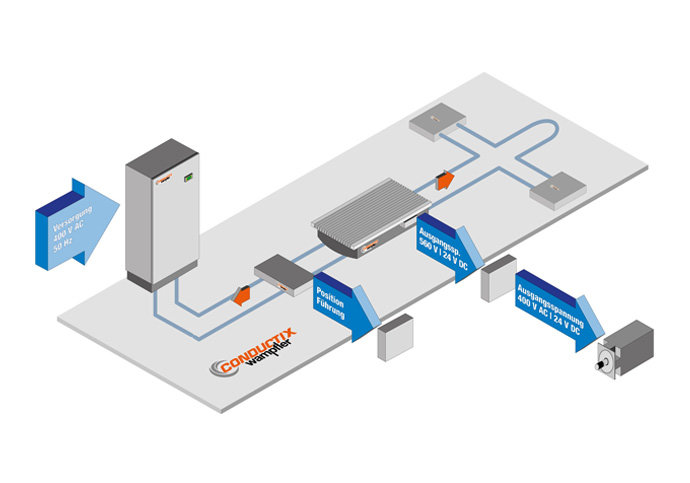Recommend
Remove File
Remove document <span id="remove-document-name"></span> from <span id="remove-cart-name"></span>?
In today’s production and material handling processes Automated Guided Vehicles (AGVs) are established as one of the most versatile solution for in-plant transports. Among all the unique advantages of this technology, there is one major challenge: the energy supply concept. For the key advantage of autonomous navigation on the factory floor – compared to track mounted systems – conventional power transmission technologies hold too many limitations.
A standard solution for this challenge is the use of on-board energy storages, like batteries or super-capacitors. These energy storages need frequent recharges. Charging can take place either on board of the AGV or outside the AGV with an energy storage swapping and charging station.
Thanks to striking technical and economical advantages contactless, inductive power transfer, often in conjunction with inductive data communication, guidance and positioning, is established as a state-of-the-art solution by now.
For floor surface conveyors, the goal is to achieve a level floor with no obstacles for persons, forklifts or other equipment in the factory environment, to eliminate hazardous contact rails, and to render batteries in vehicles either superfluous or more efficient.
To achieve this, the primary track is installed in the floor or other surface along the path of travel.
The IPT® Floorsystem can be placed continuously along the entire path of travel or only in defined areas. The advantage of continuous power transfer is the total elimination of energy storage devices on the vehicles. This cuts costs related to maintenance and replacement of batteries, and often fewer vehicles are required, since none are off-line for charging. Vehicles with their own on board power source are preferable when there are long paths that are infrequently travelled or if there are very complex or variable paths, which can make it unfeasible to put cables in the floor. Using inductive charging paths this way has the beneficial effect of permitting opportunity charging while travelling or at idle positions. iDAT is the optimum addition to continuous inductive power transfer. iDAT makes it possible to guide vehicles precisely along the magnetic field produced by the power transfer, to give them position information via position marks, and to transfer bidirectional data without interference between vehicles and the master controller.
Today IPT ® has established itself as a widespread alternative energy concept for Automated Guided Vehicles. It is predominant for AGVs integrated in the production processes such as assembly of gearboxes, engines or axles. Hybrid vehicles on the other hand, which use IPT® in conjunction with batteries or capacitors, are increasingly used for example in logistics processes. The possibility to downsize the energy storage as well as the peak power supply requirements and an increase in the overall system flexibility are the main driving factors for this development.
Referenzbericht
[REF9000-0010-D]
Anlagenbeschreibung
Motorenmontage
Betreiber
DAF, Eindhoven, Niederlande
Produkt
IPT® (Inductive Power Transfer)
Verfahrweg
200 m/100 m/80 m
Anzahl/Fahrzeuge
50
Besonderes
Energie- und Datenübertragung induktiv
Die Grundfunktion eines Inductive Power Transfer Systems, das im Boden eingebaut ist, ist grundsätzlich dieselbe wie bei allen induktiven Energieübertragungssystemen. Es gilt jedoch einige zusätzliche bzw. spezielle Anforderungen und Aspekte zu berücksichtigen.

Die Leiterschlaufe muss so in den Boden eingebracht werden, dass eine durchgängige Versorgung der Fahrzeuge entlang des gesamten Verfahrweges sichergestellt ist. Damit definiert die Leitungsverlegung im Prinzip auch schon den Verfahrweg der Fahrzeuge. Mittels induktiver Spurführung ist es möglich, das um die Leiter erzeugte Feld zu erkennen und daraus ein Führungssignal für die Fahrzeuge auszugeben und damit das Fahrzeug zu führen. Aufwändige und störende Führungsschlitze werden überflüssig. Beliebige Bahnverläufe sind realisierbar, solange durch die geometrische Anordnung sichergestellt ist, dass die Abnehmer sich immer innerhalb des definierten Feldbereiches befinden. Weichen, Kreuzungen, etc. können jederzeit realisiert werden.